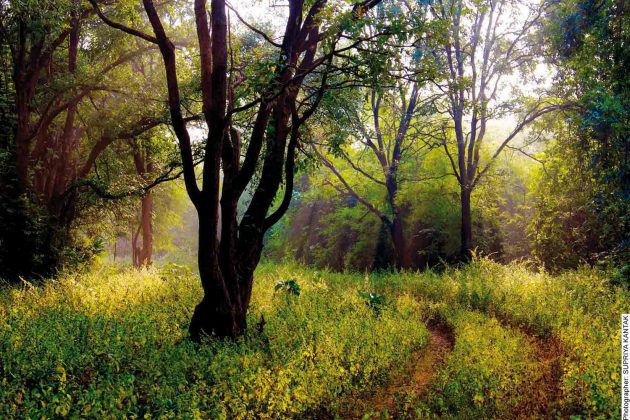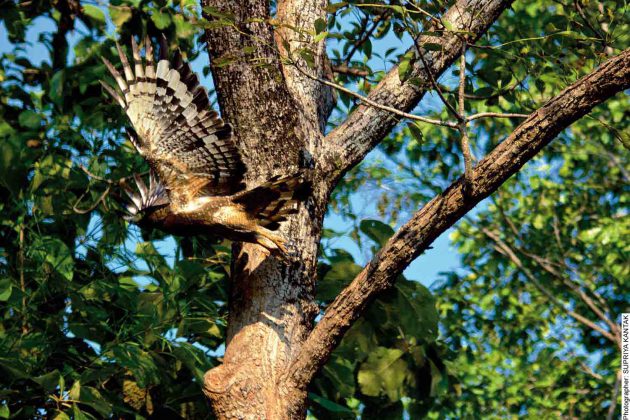Bzz Bzzz… It was not the hum of the dragonflies I had heard earlier in the day, but my alarm, sounding shocked at being set for 4 am! There was an internal war for a minute or two between my half-asleep and half-awake selves. But when I thought of the forest of Tadoba, I sprung up like a deer, and the desire to sleep vanished.
It was still dark outside and the jeep had arrived to take us to the thickets of one of India’s densest forests located in Chandrapur district, Maharashtra. I was thrilled, invigorated and anxious all at once. I had never seen a tiger in the wild before and my expectations were high. The words of a wise man resounded in my ears: do not expect anything from the forest, especially for a tiger to jump out of a bush and present itself to you; enjoy the beauty that the jungle holds, and every creature that shares the striped beast’s space. Most of all, respect Nature for all that it holds.
My four days in Tadoba were fleeting, but eye-opening nonetheless. Having been exposed only to South and East African safaris, my perception of a wildlife park differed wildly from what Tadoba offered me. Unlike the wide open plains of the Serengeti park in Tanzania, Tadoba is dense, mainly consisting of bamboo and teak trees. Its earthy landscape is a mix of mustard, browns and greens. Shrouded with trees, every corner presented a different, twisted and more gorgeous setting. Small dried-up streams had me imagining a beautiful tiger crouched down, lapping up its fill and in every thicket I could visualise its fiery eyes following my twists and turns. It was somewhere around, I could feel it but could not see it.
Tadoba is abundant in animals. On my very first safari, I spotted a leopard sprawling lazily on a tree at a distance. It was a tremendous sight—with the sunlight behind it, I could see the contours of the beast, as it leapt with agility from tree to tree. The barking deer, sambar and bison also made appearances in the time that I was there, each posing patiently while I attempted to capture their beauty in my camera. But the tiger was out of sight. Perhaps it was waiting for the right time to make its entry, as eager to make the moment perfect as I wanted.
On day three, we made our way out of the buffer zone—the outermost area of the sanctuary—after a gruelling four hours of tracking a tiger, but without luck. Our spirits were low and I grew despondent at the thought that our efforts would go in vain. And as if things couldn’t get worse, we drove headlong into massive spider webs hung over the middle of the road!
As we made our way towards the gate, the forest guards gestured frantically that we turn back. As we turned, we spotted something in the far-off distance… something massive and orange!
Rushing towards the tiger was most exhilarating. Our engines revved as we sped towards this much-awaited creature, which casually walked along the side of the road before ducking into the thickets where it rested. The moment I had been yearning for was finally here: the jeep was stationary, the tiger a few feet away, covered by the thick green fauna… its eyes, piercing my soul. The intensity of the stare was unlike any other I had ever experienced, the wisdom in those eyes seemed to tell me stories of its life in the forest.
It was more than I had imagined. I had spotted the biggest tiger in India—a resplendent male with an enormous head, known locally as ‘Waghdo’. I had only about three or four minutes to admire this beautiful creature, before it got up and disappeared into the woods. My heart yearned for more. Alas! Waghdo had other plans… he retreated to his mysterious and solitary life in the forest.
I left Tadoba with mixed feelings. I wanted to stay, I wanted to spend more time with Waghdo. But, Tadoba also opened my eyes to the harmonious nature of the wild. Whether it is the forest guinea fowl, the finches in the trees or the barking deer, it revealed the mutual respect with which these creatures co-exist. I took a piece of Tadoba home with me, a piece that I will hold close to my heart forever.
This was first published in the January 2014 issue of Complete Wellbeing.






